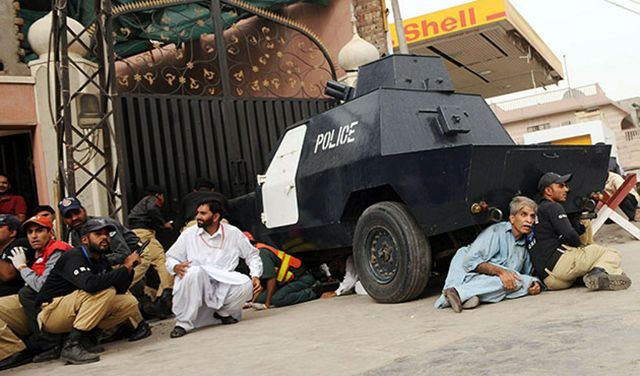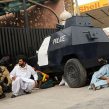
Al-Qaeda’s Ambitions in Pakistan: Changing Goals, Changing Strategies
Publication: Terrorism Monitor Volume: 8 Issue: 31
By:

President Obama’s Afghanistan-Pakistan strategy, by defining a goal of “disrupting, dismantling, and defeating al-Qaeda,” on the one hand gives direction to this otherwise directionless war, and on the other emphasizes targeting al-Qaeda over all other anti-terrorism efforts (Associated Press of Pakistan, August 2). Al-Qaeda, as innovative as it is, at least in terms of inflicting terror, has clearly taken advantage of America’s narrow focus by assuming more of a supervisory role, delegating the active terrorism responsibilities to its local franchises. Another important step al-Qaeda has taken in response to America’s stepped up military approach in Afghanistan is to focus more aggressively on the “near enemy” – Pakistan – in order to maintain a safe haven and save its high command (and ideology) from total extinction. These two fundamental changes in strategy have rattled global security strategists in general and Pakistan’s security apparatus in particular. Not used to dealing with an enemy as unconventional in nature as al-Qaeda, the rank and file of both the political and military establishments in Pakistan has been clearly outplayed by the terrorists. Moreover, Pakistan’s controversial strategic depth doctrine, which finds India at the root of every destabilization attempt, not only results in providing cover to the terrorists but the consequential anti-India sentiment also sends more and more youth into the jihadists’ fold every day. What is more frightening than the terrorism itself is the erosion of Pakistan’s social fabric and the increasing number of people, mostly from the country’s educated middle class, who embrace extremist values.. [1]
Changing Battlefields
One of the biggest breakthroughs made by al-Qaeda has been shifting the center of gravity of terrorism from Pakistan’s lawless tribal region to the more settled urban areas of Punjab and Sind provinces. Having penetrated into Pakistani society through local terrorist outfits, al-Qaeda’s goal in Pakistan is twofold:
• Exacerbate the already existing fault lines which divide Pakistanis into different ethnic, political and religious factions, as well as encourage social divisions between the rich and poor by fueling violence between the two social classes.
• Refashion the socio-political identity of Pakistanis in the spirit of al-Qaeda’s interpretation of Islam – a system that promises harsh Shari’a-compliant justice and “freedom” from “godless” democratic systems of governance that breed corruption and “moral decadence” in society. [2]
These seemingly ambitious goals, which may have looked impossible only two years ago, are very much a reality today. According to recent opinion surveys, discontent among Pakistanis has risen to an alarming 84%, more than 60% of its youth are cynical about democracy and one third strongly supports the implementation of Shari’a law. [3] In this environment, al-Qaeda surely sees a window of opportunity in Pakistan. Moreover, the government’s inability to provide even the basic amenities of life to the masses, let alone to curb terrorism, is only expediting the disaster and has the potential to jeopardize the security of the whole region.
Al-Qaeda’s longing to convert Pakistan into a Shari’a state is not new. In his attempt to discredit Pakistan’s political structure, Osama bin Laden’s deputy, Dr. Ayman-al-Zawahiri, has penned a series of statements and articles, including a 130 page monograph entitled The Morning and the Lamp: A Treatise Regarding the Claim that the Pakistani Constitution Is Islamic (see Terrorism Monitor, March 19). In this monograph, Zawahiri carried out an in depth analysis of Pakistan’s constitution, arguing that all the institutions of state in Pakistan are in conflict with Islam and that it is virtually impossible to promulgate Shari’a in a Western-style democratic system.
The Campaign Against the Pakistani State
Despite al-Qaeda’s vociferous attacks on the state of Pakistan since 2001, it was not until about two years ago that the movement started taking concrete steps towards realizing its dream of tearing down the Pakistani state. The late Abu Mustafa al-Yazid, al-Qaeda’s chief of operations in Afghanistan and Pakistan before being killed in a South Waziristan drone attack in May, established the organization’s “Pakistan bureau” by forging alliances with local organizations like Lashkar-e-Jhangvi (LeJ), Harkat ul-Jihad al-Islami (HuJI), and Ilyas Kashmiri’s 313 Brigade, to name the most prominent. This change in policy allowed Pakistanis for the first time to rise in the ranks of al-Qaeda – previously an Arab (mainly Egyptian) dominated organization. In order to please its local partners, al-Qaeda also started taking responsibility for activities in which it had not shown much interest before, such as terrorist attacks on India by Pakistani groups, as well as providing support for the military struggle in Kashmir. [4] Since then, the partnership between the two has only strengthened, and terrorist activities have intensified in Pakistan. Never articulated in such depth before, al-Qaeda’s long term vision of Pakistan was elaborated by its chief media spokesperson for Pakistan, Ustadh Ahmad Farooq – another Pakistani – in a recent interview with al-Qaeda’s media wing:
"We are trying to create and to liberate a Pakistan that will be a pure Shari’a governed state and that will be a safe center for all Muslims from any place in the world, irrespective of their color, race or geographical origin. We are doing jihad for a Pakistan that will be a center of the mujahideen and of Muslims who would be able to come to Pakistan without any restrictions" (As-Sahab Media Productions, July 12).
An Expanding List of Targets
Recent Lahore attacks on Ahmadi mosques (May 28) and the Data Darbar Sufi shrine (July 1) indicate the broadening of the terrorists’ agenda, which previously had a narrow focus on military and intelligence officials. Intent on forcibly changing the fabric of Pakistani society, al-Qaeda’s Pakistan bureau seems to have expanded the list of its targets by including centers of power that have the potential to affect its agenda by shaping the public discourse against stricter interpretations of Islam. Notable scholars of the majority Barelvi sect like Maulana Sarfaraz Ahmed Naeemi (assassinated by the Tehrik-e-Taliban Pakistan [TTP] on June 12, 2009), as well as educated members of the Shi’a and Ahmadi minorities, seem to match the profile and are taking the brunt of the emboldened Salafist campaign (Dawn [Karachi], June 13, 2009). At least 4,000 Shi’a have been gunned down in targeted killings throughout the country in the last two years (Dawn, June 24). In Punjab alone, since 2006 1,312 security personnel and civilians have been killed in 174 terrorist attacks (figures from South Asian Terrorism Portal). Unlike the Pashtun Taliban, which recruits mostly from local tribes, the Punjabi Taliban represent a wide cross-section of Pakistan’s rural and urban middle class and are therefore difficult to find among the common people. Moreover, these loose outfits, which previously used to operate independent of each other, have emerged under the supervision of al-Qaeda as a “network of networks,” with each constituent terrorist organization specializing in a particular city/region or terrorist activity.
An example of this coordination is found in the recent wave of terrorism in Punjab. According to intelligence reports, the LeJ, with its strong intelligence network throughout Punjab, carried out the task of identifying the targets and conducting surveillance of specific installations (Daily Times [Lahore], July 12). Responsibility for providing logistical support, i.e. suicide vests, explosives and safe havens, was delegated to HuJI, while the TTP provided suicide bombers. Such a sophisticated and coordinated campaign of violence against the Pakistani people is a clear indication that the terrorists’ agenda is to forcibly change the outlook of Pakistani society and is not merely focused on isolated attacks against Pakistan’s security apparatus, as argued by many.
Conclusion
The response from the government of Pakistan to this most dangerous of threats is puzzling, to say the least. The nation’s political leadership, which wholeheartedly supported the military operations in the tribal areas, is more than divided on chalking out a similar strategy against an al-Qaeda-Punjabi Taliban nexus. Huge gains achieved against the terrorists in initially successful military operations in Swat, Buner, Bajaur, and South Waziristan have been squandered by self-serving politicians who impede the capture of terrorists hiding in their constituencies in Punjab. The expanding number of self-proclaimed analysts who thrive on made-up conspiracy theories mislead the people by fueling anti-American sentiment. The confusion that is created in the resulting mayhem is doing little to pacify the concerns of the Pakistani public who, having lost faith in politicians and democracy, are beginning to look towards the promised Shari’a state to at least bring order to their lives.
Pakistan has a troubled history of ethnic feuds, sectarian bloodshed and linguistic politics. There are layers upon layers of confused identities which have kept 170 million individuals from becoming one nation. Exploiting these social fractures to its benefit is the heart of al-Qaeda’s well-planned strategy to break into Pakistani society and to use it as a base for terrorist operations in the rest of the world. Indifferent to the looming danger of potential state failure at the hands of terrorism, the Pakistani leadership seems to underestimate the level of this threat, while terrorists chip away at its legitimacy one attack at a time.
Notes
1. According to the Pew Global Attitudes survey “Pakistani Public Opinion” (August 2009), a growing percentage of Pakistanis favor strict implementation of Shari’a and harsh punishments. The survey suggested that 83% support stoning people who commit adultery; 80% favor punishments like flogging and amputation of hands for crimes like theft and robbery and 78% support the death penalty for people who leave the Muslim religion.
2. Al-Qaeda’s vision for Pakistan, although not presented by its leadership in a coherent strategic document, can be cobbled together by reviewing statements and essays produced by its leaders over the last 10 years. See especially “The Morning and the Lamp – A critique of the Constitution of Pakistan,” by Dr. Ayman al Zawahiri; see also “Why Jihad in Pakistan” – a recent statement by al-Qaeda’s spokesperson for Pakistan, Ustadh Ahmad Farooq, laying out al-Qaeda’s vision of a Shari’a state in Pakistan; and Zawahiri’s message “To the Pakistan Army and the People of Pakistan,” August 10, 2008.
3. 22 Nations Pew Global Attitudes Survey, June 17, 2010, https://pewglobal.org/files/pdf/Pew-Global-Attitudes-2010-Pakistan-Report.pdf);
British Council Survey of Pakistani youth, November 2009, (https://www.guardian.co.uk/world/2009/nov/20/pakistan-younger-generation-democracy-report).
4. In a posthumously released audio message, Mustafa Abu al-Yazid accepted responsibility for the attack on the German Bakery in Puneh India, which killed 20 people on February 13 2010, and praised Ilyas Kashmiri, a Pakistani jihadist, by saying, “The person who carried out this operation was a heroic soldier from the ‘Soldiers of the Sacrifice Brigade,’ which is one of the brigades of Qaedat al-Jihad [al-Qaeda’s formal name] in Kashmir, under the command of Commander Illyas Kashmiri, may Allah preserve him” (The Hindu, July 10).





